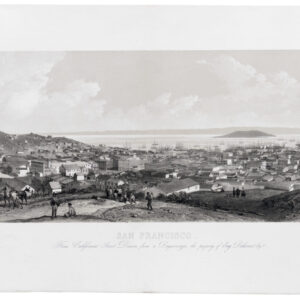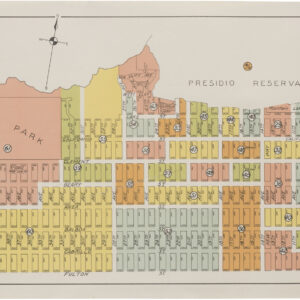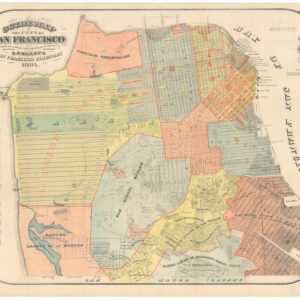Revealing the early 20th century Chinese experience in the Bay Area: a roaring ’20s map of San Francisco’s Chinatown.
Meiguo Sanfan Shi hua qiao qu : xiang xi tu. / Map of San Francisco Chinatown.
Out of stock
Description
This rare and highly detailed 1929 document of San Francisco’s Chinatown was the first map made by Chinese Americans of San Francisco for the Chinese community. It was officially commissioned by the Chinese Consolidated Benevolent Association, an organization dedicated to supporting Chinese businesses and the Chinese community in San Francisco.
It is thought that the map was also used by Chinese Tong crime syndicates running protection rackets. The careful detailing of all Chinese businesses would have been an invaluable resource to the Tongs looking to extort protection money.
The main map shows San Francisco’s downtown from Powell St. (at the top—the map is oriented to the west) to Montgomery St. (at the bottom) and from Bush St. on the left to Broadway on the right.
An inset map in the upper left shows San Francisco’s downtown in the northeast corner of the peninsula, including San Francisco’s waterfront, and Chinatown’s placement within. On the lower left is an inset showing a larger segment of the Bay Area, most notably Oakland, and Oakland’s considerable Chinatown (to which many San Franciscan Chinese had moved following the 1906 earthquake and fire). That inset also includes Angel Island (site of the immigration station at which Chinese immigrants were required to report when seeking entry to the US) and Sausalito to the north, and identifies ferry routes across the bay.
Although the map title, the street names, a few businesses, and the towns have their names written in English (sometimes accompanied by a Chinese translation), most of the legends and labels are in Chinese. In the main map, most of the businesses and buildings of Chinatown are labeled exclusively in Chinese. Of those in English, most are apparently Japanese (e.g., the Nippon Trading Co., or The Meiji at the south end of Grant St.), though some few are English names.
San Francisco’s Chinatown
In 1848, San Francisco was just a small outpost, not yet even a legal possession of the United States, at the time gold was discovered at Sutter’s Mill, in the Sierra foothills, east of the city. Among those who flocked to the rapidly growing city in search of gold were many Chinese, and soon their community became (and has remained to this day) the largest Chinese enclave outside Asia.
The 1906 fire after the great earthquake destroyed Chinatown, but it was soon rebuilt on its original site, despite pressure from many in the San Francisco establishment to move it away from the downtown center.
In the 1920’s, Chinatown, like many places in America, was subject to organized crime, but unlike most of the organized crime, Chinatown’s was perpetrated by the Chinese Tongs—organizations ostensibly aimed at supporting the Chinese community, but willing to engage in criminal activities as well, especially extorting local businesses for protection.
Chinese Consolidated Benevolent Association (a.k.a. The Chinese Six Companies)
The Chinese Consolidated Benevolent Association served as a representative for the wider Chinese community in political and public arenas. Businesses in the community paid dues to the Benevolent Association, and this map, with its careful detail of businesses, would have been a valuable aid in collection of dues, as well as serving as a guide for a Chinese person in San Francisco.
The Tongs
The Chinese Tongs are officially organizations for Chinese migrant populations in the US and elsewhere—the word “tong” means gathering place—but they have often partaken in criminal activities. They are often described as “secret societies,” but they also have publicly marked offices and meeting halls. They have long been a significant part of the history of San Francisco. Although the Roaring Twenties did not, perhaps, meet the level of violence of the Tong Wars of the late 19th century, the Tongs in San Francisco did run protection/extortion rackets, among other illegal activities. For them, as for the dues-collecting Benevolent Association, this map would have been an invaluable resource for managing their collection of “protection”money, and it has been reputed that copies of this map were, in fact, used by the Tongs.
Cartographer(s):
J. P. Wong (Huang Huapei, 1901-1988) was born in China and emigrated with his family to San Francisco in 1913. Given that the Chinese Exclusion Act of 1882 was in effect, limiting emigration to the family of US residents, it is possible that Wong was one the wave of immigrants who sought entry to the US after the San Francisco earthquake and fire destroyed San Francisco’s municipal records, allowing many to claim citizenship or family relationships for immigration on the basis of documents allegedly lost in the fires. In 1922, Wong joined the Kuomintang (KMT), the Chinese Republican Party that ruled much of China from the end of the Warlord era until the success of the Chinese Communist Party (CCP) in 1949. Wong’s primary work was with the KMT. In the ’20s, he raised money for the party in SF, and was one of the local KMT officers. In 1929, he returned to China, where he stayed until the CCP takeover of mainland China in 1949, when he returned to San Francisco. Outside of his work for the KMT, Wong had a varied career. He might have spent some time working for a newspaper, and he was also arrested for his involvement in a roaring twenties bootlegging ring. Later in his life, after his return to the US, he became part owner of the Hang Ah Tea Room in San Francisco, which is still operating to this day. In his time, it was a center for KMT organizing in the US. Wong passed away in San Francisco in 1988.
Wong was not, by career, a cartographer, this being the only known map made by him.
Condition Description
Very good, some wear along bottom edge.
References
Rumsey 10300.000. OCLC 54387328. Boston Public Library Norman B. Leventhal Map Center G4364.S5:2C45G46 1929 .W66.





















![Inside [San Francisco]](https://neatlinemaps.com/wp-content/uploads/2019/11/NL-00737-scaled-300x300.jpg)